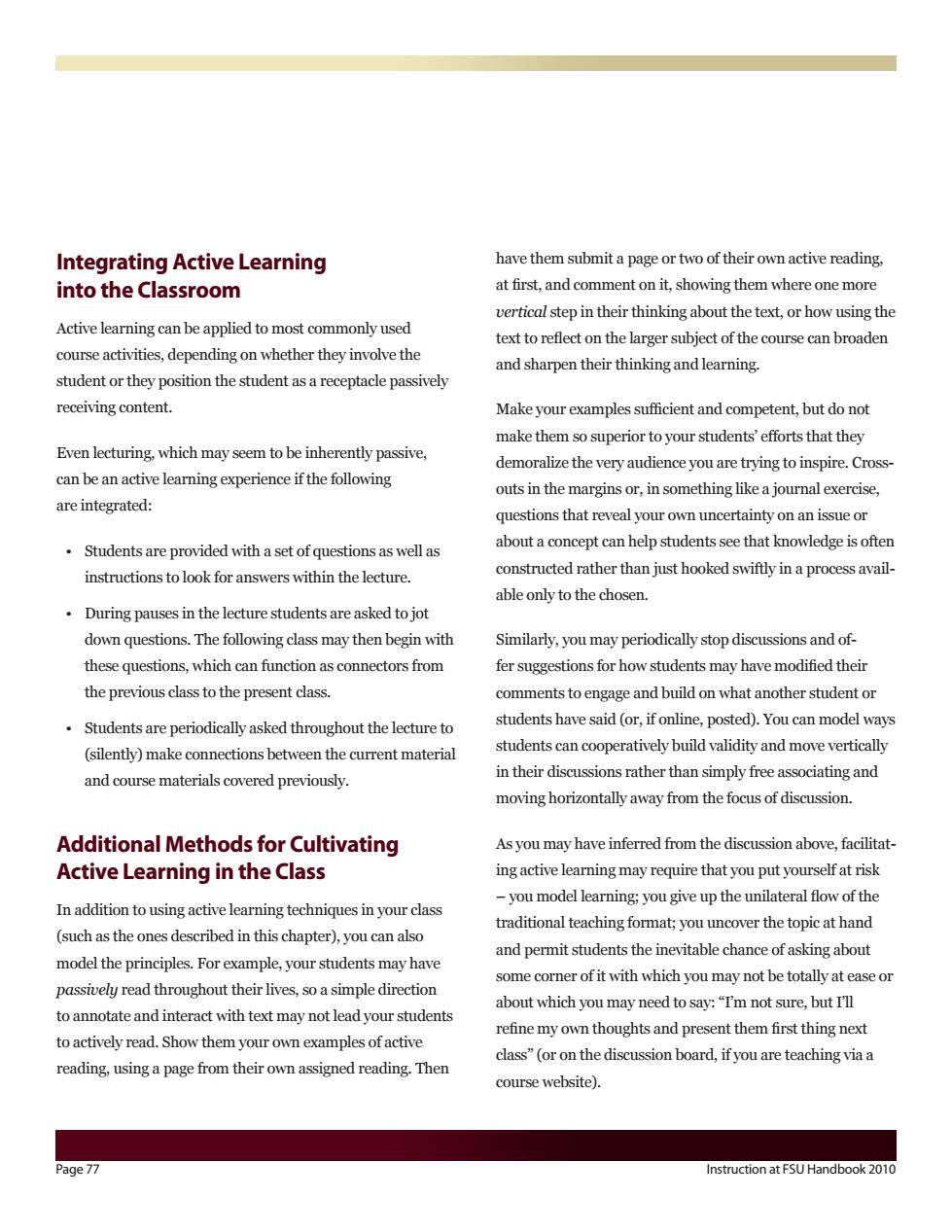正在加载图片...

Integrating Active Learning have them submit a pageor two of theirown active reading. into the Classroom at first,and comment on it,showing them where one more vertical step in their thinking about the text,or how using the Active learning can be applied to most commonly used text to reflect on the larger subiect of the course can broaden course activities,depending on whether they involve the and sharpen their thinking and learning. student or they position the student as a receptacle passively receiving content. Make your examples sufficient and competent,but do not make them so superior to your students'efforts that they Even lecturing,which may seem to be inherently passive, demoralize the very audience you are trying to inspire.Cross can be an active learning experience if the following outs in the marginsor,in something like a journal exercise. are integrated: questions that reveal your own uncertainty on an issue or Students are provided with a set of questions as well as about a concept can help students see that knowledge isofter constructed rather than iust hooked swiftly in a process avail- instructions to look for answers within the lecture. able only to the chosen. During pauses in the lecture students are asked tojot down questions.The following class may then begin with Similarly,you may periodically stop discussions and of- these questions,which can function as connectors from fer suggestions for how students may have modified their the previous class to the present class. comments to engage and build on what another student or Students are periodically asked throughout the lecture to students have said (or,if online,posted).You can model ways (silently)make connections between the current material students can cooperatively build validity and move vertically and course materials covered previously. in their discussions rather than simply free associating and moving horizontally away from the focus of discussion. Additional Methods for Cultivating As you may have inferred from the discussion above,facilitat Active Learning in the Class ing active learning may require that you put yourself at risk In addition to using active learning techniques in your class -you model learning:you give up the unilateral flow of the (such as the ones described in this chapter) traditional teaching format;you uncover the topic at hand and permit students the inevitable chance of asking about model the principles.For example,your students may have some corner of it with which you may not be totally at ease o passively read throughout their lives,soa simple direction about which you may need to say:"I'm not sure,but I'll to annotate and interact with text may not lead your students refine my own thoughts and present them first thing next to actively read.Show them your own examples of active reading,using a page from their own assigned reading.Then class"(or on the discussion board,ifyou are teaching via a coursewebsite). nstruction at FSU Hand Page 77 Instruction at FSU Handbook 2010 have them submit a page or two of their own active reading, at first, and comment on it, showing them where one more vertical step in their thinking about the text, or how using the text to reflect on the larger subject of the course can broaden and sharpen their thinking and learning. Make your examples sufficient and competent, but do not make them so superior to your students’ efforts that they demoralize the very audience you are trying to inspire. Crossouts in the margins or, in something like a journal exercise, questions that reveal your own uncertainty on an issue or about a concept can help students see that knowledge is often constructed rather than just hooked swiftly in a process available only to the chosen. Similarly, you may periodically stop discussions and offer suggestions for how students may have modified their comments to engage and build on what another student or students have said (or, if online, posted). You can model ways students can cooperatively build validity and move vertically in their discussions rather than simply free associating and moving horizontally away from the focus of discussion. As you may have inferred from the discussion above, facilitating active learning may require that you put yourself at risk – you model learning; you give up the unilateral flow of the traditional teaching format; you uncover the topic at hand and permit students the inevitable chance of asking about some corner of it with which you may not be totally at ease or about which you may need to say: “I’m not sure, but I’ll refine my own thoughts and present them first thing next class” (or on the discussion board, if you are teaching via a course website). Integrating Active Learning into the Classroom Active learning can be applied to most commonly used course activities, depending on whether they involve the student or they position the student as a receptacle passively receiving content. Even lecturing, which may seem to be inherently passive, can be an active learning experience if the following are integrated: • Students are provided with a set of questions as well as instructions to look for answers within the lecture. • During pauses in the lecture students are asked to jot down questions. The following class may then begin with these questions, which can function as connectors from the previous class to the present class. • Students are periodically asked throughout the lecture to (silently) make connections between the current material and course materials covered previously. Additional Methods for Cultivating Active Learning in the Class In addition to using active learning techniques in your class (such as the ones described in this chapter), you can also model the principles. For example, your students may have passively read throughout their lives, so a simple direction to annotate and interact with text may not lead your students to actively read. Show them your own examples of active reading, using a page from their own assigned reading. Then